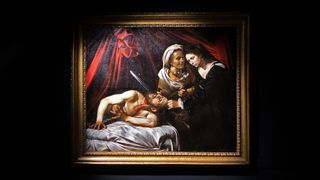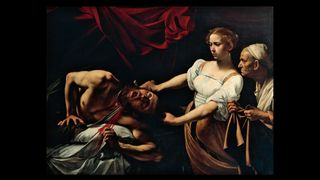'Lost' Caravaggio Painting Worth $170 Million Bought Before Auction — But Is It Authentic?

A previously unknown Caravaggio painting that was found just a few years ago was expected to fetch up to $170 million at auction this week — but it never made it to the auction block.
Instead, an unnamed buyer quietly purchased the painting yesterday (June 25) before the June 27 auction in Toulouse, France, could take place, The Guardian reported.
The sumptuously painted canvas shows the grisly biblical scene of Judith — a Jewish woman — beheading the Assyrian general Holofernes, to save her people. Caravaggio is already known for immortalizing this gruesome tale in the painting "Judith and Holofernes," which he finished around 1598 or 1599. [30 of the World's Most Valuable Treasures That Are Still Missing]
But is this alternate version of the bloody beheading a genuine Caravaggio? Several experts have doubts, according to The Guardian.
The "lost" Caravaggio surfaced in a Toulouse home in April 2014, CNN reported that year. After homeowners found the dusty, water-stained canvas in the attic during a renovation, they contacted a friend named Marc Labarbe, who was also a fine art auctioneer.
Labarbe then sent a photo of the painting to Eric Turquin, a well-respected Parisian art appraiser and Old Masters expert, for analysis; two years later, Turquin declared that the artwork had been painted by Michelangelo Merisi da Caravaggio, Reuters reported in 2016.
"A painter is like us — he has tics. And you have all the tics of Caravaggio in this," Turquin told Reuters TV. What's more, Caravaggio is thought to have created another painting of Judith and Holofernes in 1606, according to records dating to 400 years ago, Turquin told The Guardian.
Sign up for the Live Science daily newsletter now
Get the world’s most fascinating discoveries delivered straight to your inbox.

X-rays and cleaning revealed that the attic painting underwent many revisions with "lots of retouching," which experts see as a sign that a painting is not a forgery or copy, Turquin said. But several experts dispute the painting's provenance, Richard Spear, an Italian Baroque expert at Princeton University, told The Art Newspaper.
Some suggest that the painting is the work of Flemish artist Louis Finson, a contemporary of Caravaggio. Others propose that Finson completed the painting that Caravaggio left unfinished in 1607, after he fled Malta to escape a death sentence for murdering a man in a street brawl, according to The Guardian.
Auction representatives declined to disclose the buyer's identity or the painting's selling price, but the artwork is bound for an unnamed "great museum" outside of France, where it will be on display to the public, Reuters reported.
- 9 Famous Art Forgers
- 11 Hidden Secrets in Famous Works of Art
- 7 Biblical Artifacts That Will Probably Never Be Found
Originally published on Live Science.

Mindy Weisberger is an editor at Scholastic and a former Live Science channel editor and senior writer. She has reported on general science, covering climate change, paleontology, biology and space. Mindy studied film at Columbia University; prior to Live Science she produced, wrote and directed media for the American Museum of Natural History in New York City. Her videos about dinosaurs, astrophysics, biodiversity and evolution appear in museums and science centers worldwide, earning awards such as the CINE Golden Eagle and the Communicator Award of Excellence. Her writing has also appeared in Scientific American, The Washington Post and How It Works Magazine. Her book "Rise of the Zombie Bugs: The Surprising Science of Parasitic Mind Control" will be published in spring 2025 by Johns Hopkins University Press.
Most Popular


